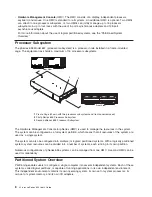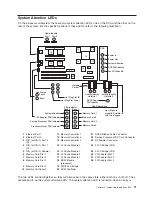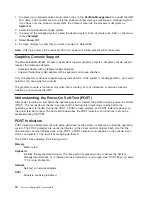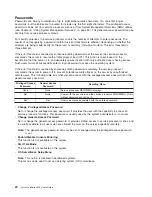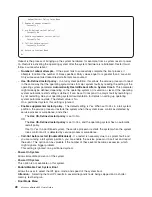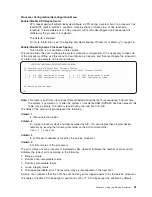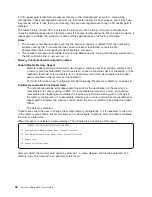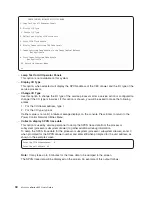
Chapter
4.
Using
the
Service
Processor
Note:
The
information
in
this
chapter
regarding
the
configuring
of
serial
ports
does
not
apply
to
the
serial
ports,
or
modems
attached
to
those
serial
ports,
on
the
Hardware
Management
Console
(HMC).
The
service
processor
runs
on
its
own
power
boundary
and
continually
monitors
hardware
attributes
and
the
environmental
conditions
within
the
system.
The
service
processor
is
controlled
by
firmware
and
does
not
require
the
operating
system
to
be
operational
to
perform
its
tasks.
The
service
processor
menus
allow
you
to
configure
service
processor
options,
as
well
as
enable
and
disable
functions.
Service
processor
menus
are
available
using
an
HMC
virtual
terminal
window
when
OK
is
displayed
on
the
virtual
operator
panel
or
when
the
service
processor
has
detected
a
server
problem
(such
as
a
surveillance
failure).
Service
Processor
Menus
The
service
processor
menus
are
divided
into
the
following
groups:
v
General
user
menu
-
the
user
must
know
the
general-access
password.
v
Privileged
user
menus
-
the
user
must
know
the
privileged-access
password.
If
the
server
is
powered
off,
the
service
processor
menus
can
be
accessed
on
the
HMC.
Accessing
the
Service
Processor
Menus
Service
processor
menus
are
accessed
by
opening
a
virtual
terminal
window
on
the
HMC.
After
OK
displays
in
the
virtual
operator
panel
on
the
HMC,
press
any
key
on
the
keyboard
to
signal
the
service
processor.
When
you
gain
access,
the
service
processor
prompts
you
for
a
password
(if
one
is
set),
and
when
verified,
displays
the
service
processor
menus.
The
service
processor
menu
prompt,
represented
by
0>
on
the
HMC,
indicates
the
serial
port
to
which
the
terminal
is
connected.
Saving
and
Restoring
Service
Processor
Settings
All
the
settings
that
you
make
(except
language)
from
the
service
processor
menus
can
be
backed
up
either
for
recovering
from
a
fault
that
may
corrupt
these
settings,
or
for
replicating
these
settings
to
other
servers
that
include
a
service
processor.
The
service
aid,
Save
or
Restore
Hardware
Management
Policies,
can
be
used
to
save
your
settings
after
initial
setup
or
whenever
the
settings
must
be
changed
for
system
operation
purposes.
It
is
strongly
recommended
that
you
use
this
service
aid
for
backing
up
service
processor
settings
to
protect
the
usefulness
of
the
service
processor
and
the
availability
of
the
server.
Refer
to
″
Save
or
Restore
Hardware
Management
Policies,
″
in
the
″
Introduction
to
Tasks
and
Service
Aids
″
section
of
the
RS/6000
and
Eserver
Diagnostic
Information
for
Multiple
Bus
Systems
.
It
is
strongly
recommended
that
you
use
this
service
aid
for
backing
up
service
processor
settings
to
protect
the
usefulness
of
the
service
processor
and
the
availability
of
the
server.
For
information
about
this
service
aid,
refer
to
“Save
or
Restore
Hardware
Management
Policies,”
in
“Introduction
to
Tasks
and
Service
Aids”.
19
Summary of Contents for p 655 series
Page 1: ...pSeries 655 User s Guide SA38 0617 03 ERserver...
Page 2: ......
Page 3: ...pSeries 655 User s Guide SA38 0617 03 ERserver...
Page 10: ...viii Eserver pSeries 655 User s Guide...
Page 14: ...xii Eserver pSeries 655 User s Guide...
Page 16: ...xiv Eserver pSeries 655 User s Guide...
Page 24: ...6 Eserver pSeries 655 User s Guide...
Page 32: ...14 Eserver pSeries 655 User s Guide...
Page 36: ...18 Eserver pSeries 655 User s Guide...
Page 90: ...72 Eserver pSeries 655 User s Guide...
Page 144: ...126 Eserver pSeries 655 User s Guide...
Page 208: ...190 Eserver pSeries 655 User s Guide...
Page 214: ...196 Eserver pSeries 655 User s Guide...
Page 217: ......




